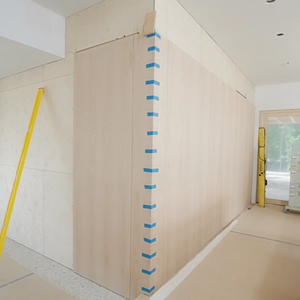Bad, not big, homes are the problem
I love and applaud the concepts behind architect Sarah Susanka’s approach to home design: optimizing function, utility, cost, and energy consumption to fit the way an individual really lives, which often results in a much smaller house than other design approaches. But I was disappointed to read Kevin Ireton’s editorial lamenting the increasing average size of homes ( FHB #198, “Letters”). Mr. Ireton is correct that we do need to build better houses, but the overall size should be the result of proper design, not the driver of it. There is no ubiquitous way that “we” really live.
There is the way you live, and there is the way I live, and if they’re not the same, then we should live in different houses. If you prefer a smaller house for whatever particular reason, then by all means pursue the perfection of your preference, but don’t pretend that your opinion is truth. Most protestations about large homes are based on class envy or an inarticulate social statement decrying conspicuous consumption rather than on a rational evaluation of function, cost, and energy use. To be sure, there are many large homes that are nothing more than a manifestation of the owner’s or builder’s ego, but that is an indictment of those particular houses, not large houses in general.
If you want to argue that more of us should change our lifestyle so that we don’t want or need large homes, that is a worthwhile discussion, but not one that belongs in Fine Homebuilding. Meanwhile, I hope your readers are smart enough to realize that there is no virtue in any particular size of home, large or small, unless it is designed and built to meet the needs of the occupants and the community. This pursuit usually requires compromises between the oft-competing agendas of homeowners, homebuilders, architects, and communities, but it’s a worthy pursuit that ends up producing better homes for all of us. So I will ask Mr. Ireton’s original question back to him: Will you ever learn?
—Edward O’Kelly, Evergreen, Colo.
Liquid membranes can be counterflashed
As developer of the Wet-Flash materials recently mentioned in your “Letters” column(FHB #198), I would like to respond to Rob Moody’s contention that a liquid-applied waterproof membrane cannot be counterflashed or is unable to be installed in a lapped fashion.
Counterflashing is addressed at the sill by incorporating a durable textile embedded into the liquid-applied material prior to cure. This fabric is loose beyond the sill and allows the currently used weather-resistant barriers to be installed underneath, in lap fashion. You can see several installation demos on our Web site, www.wet-flash.com. Other details, regardless of complexity, can be addressed as easily. A liquid-applied material can reduce lapping issues at the most-likely-to-leak (and most stapled) conditions in the building envelope.
As a testing company, we look at the performance of construction products as they are installed and exposed on job-site environments. This view can reveal the disparity between the expected performance as listed on a company’s literature and the actual results to a structure after a storm. It can be argued that much interest has been placed in the waterproofing of buildings, but if we are not testing, we are simply guessing.
—Tom Schneider, Building Envelope Innovations, LLC
A safer railing
On p. 72 of the October/ November issue (FHB # 198), in the article “Durable Deck Stairs,” my eye immediately went to the terminal ends of the stainless-steel cables on the bottom newel posts. The protruding ends are dangerous. A safer way would be either to counterbore holes in the post to accept the threaded ends of the cable or to build a box around the ends and screw the box to the posts so that the wires can be adjusted from time to time by removing the top of the box.
On the other hand, I really liked the attachment of the bottom newel posts with all-thread and plan on using that application on my next set of exterior wood stairs. Sign me a longtime, loyal subscriber and reader of your fine magazine.
—Dana Lubow, via email
Disappointed by wood-heat article
As a respected member of the hearth-products industry, we at Wittus-Fire by Design were disappointed that the article “Is Wood Heat the Answer?” (FHB #198) did not have the quality and accuracy expected of your magazine. Although the article was informative, it contained some misleading information and did not show a complete picture of wood burning today.
Missing was a discussion of contemporary designs, cookstoves, freestanding fireplaces, and rotating stoves. In the section on fireplaces, the assertion that zero-clearance fireplaces provide ambience but not heat is not necessarily true. Zero clearance just means the fireplace can be installed without clearance requirements. Also, we advise that wood to be burned in a woodstove should dry for two years, not six months.
As for masonry heaters, our research shows that they reach 90% efficiency if built and used properly, not 95%. The article also fails to mention that they typically weigh 3000 lb. to 6000 lb. Additionally, readers should have been warned that manufacturers of pellet stoves are backed up in production for this year, and there has been a shortage of pellets over the past few years.
Finally, we thought the concepts of combustion efficiency (how well and completely a stove burns fuel) and heating efficiency (how quickly it heats and dissipates) were muddled and misleading.
Despite our concerns, however, we agree with the article’s bottom line: Wood heat is an economically wise alternative, and burning wood is a good thing!
—Alyce Witus, Pound Ridge, N.Y.
Defending pellet stoves
I was pleased to see your article on heating with wood (FHB #198). On the other hand, I was surprised by the seemingly negative commentary on pellet stoves.
I have a freestanding Avalon Astoria pellet stove that I installed in my new home about a year and a half ago. From the outset, I planned to heat as much of the house as possible with the stove and designed the entire family room around it. I’m happy to say that we heated 75% of the house (3770 sq. ft.) with it last year, and it was superb. It took just more than 2 1/2 tons of pellets at a total cost of about $640 here in the mountains of western North Carolina. The author’s comments might steer some folks away from these excellent alternatives to fireplaces and conventional woodstoves.
Why a pellet stove? For starters, there is no messy wood to deal with. Pellets are made from wood waste and come in easy-to-store, easy-to-maneuver 40-lb. bags. Next, there are no matches or exposed flames because the stove’s operation is automatic. My wife hates lighting fires, which was a big reason we opted for a pellet burner. The glass-front door allows you to enjoy the flames, which I’ll grant tend to look like a blowtorch at times. Then there is the thermostatic operation of the stove. Ours cycled like clockwork all last winter, and we’d come and go with zero worries of it operating reliably.
Granted, pellet stoves require weekly maintenance. Every five to seven days, the stove has to be powered down and cleaned, a procedure that takes from 15 to 20 minutes. The annual maintenance is a bit more involved, taking from three to four hours, which includes cleaning the flue. But overall, I have no regrets with my choice and would happily buy another. I’d encourage your readers to take another look.
—.James R. Freeman Jr., Franklin, N.C.
Problem with Festool’s miter saw?
With regards to Justin Fink’s review of the Kapex miter saw from Festool (FHB #197), I have been considering purchasing one. Then I read about a defect that causes a grinding noise when changing the miter angle. I understand that Festool acknowledges the problem and will send out replacement parts to people who bought units with the problem. My concern is that Festool continues to sell the Kapex at $1300 without solving the grinding issue. The Kapex is an amazing tool, and I will more than likely buy one. But until they get this sorted out, I am keeping my money.
—Bob Luciano, via email
Associate editor Justin Fink replies: The grinding noise you refer to wasn’t a problem on the saw that I tested, but I have heard similar complaints since we published the review. I spoke with Festool product manager Rick Bush about the problem, and he explained that the noise is created by a clearance issue with the miter-lock mechanism. Festool has corrected the issue at the production line, fixed every saw in their inventory, and spot-checked saws at distributor locations to make repairs. Bush encourages any Kapex owners that experience the problem to call 800-554-8741 for a free repair with no shipping cost to the user.
Comments on drop-down door seals
I have had drop-down door seals on a pair of in-swinging French entry doors since 1992 and would like add a few points that Jay B. Lane did not cover in his recent article “Stop Drafts With a Drop-Down Door Seal” (FHB #198).
Mr. Lane shows the bottom lip of the seal housing sitting proud of the door bottom and fastened with panhead screws. My seal was installed exactly this way. Over time, my threshold warped slightly, and the screw heads scraped cross grain over the threshold. The next time I install a drop-down door seal, I will mortise the flange of the door seal flush with the door bottom.
Also, Mr. Lane glued his door seal in place with urethane sealant. The spring in the Pemko seal is steel and will rust. The time may come when the seal will need to be replaced, so the urethane caulk is probably best applied just to the edges of the seal, not to the entire bed.
—James Gealy via email
Fine Homebuilding Recommended Products
Fine Homebuilding receives a commission for items purchased through links on this site, including Amazon Associates and other affiliate advertising programs.

Reliable Crimp Connectors

Handy Heat Gun

Affordable IR Camera






















